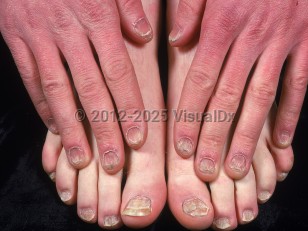Trachyonychia - Nail and Distal Digit
Alerts and Notices
Important News & Links
Synopsis

Clinically, trachyonychia is divided into 2 types: shiny and opaque. In the shiny type, there is ridging and pitting, but nails retain their natural luster. In the opaque type, which is generally more severe, nails are rough, brittle, and thin with ridging caused by superficial striations. In both types, there may be thickened cuticles, onychoschizia, and koilonychia.
Trachyonychia may affect all age groups. It most commonly affects children and is typically idiopathic. In children, it usually affects all 20 nails. Trachyonychia is reported in 4% of patients with alopecia areata. Other dermatologic disease associations are psoriasis, lichen planus, and, less commonly, atopic dermatitis, ichthyosis vulgaris, vitiligo, and pemphigus vulgaris. Systemic disease associations include amyloidosis, sarcoidosis, primary biliary cirrhosis, and hematologic disease. Drugs such as chemotherapeutic agents may cause trachyonychia.
Histopathology of trachyonychia typically shows spongiosis with inflammatory cell exocytosis into the nail epithelia. There may be findings of nail matrix lichen planus or psoriasis in some cases.
Codes
L60.3 – Nail dystrophy
SNOMEDCT:
238719003 – Twenty nail dystrophy
Look For
Subscription Required
Diagnostic Pearls
Subscription Required
Differential Diagnosis & Pitfalls

Subscription Required
Best Tests
Subscription Required
Management Pearls
Subscription Required
Therapy
Subscription Required
Drug Reaction Data
Subscription Required
References
Subscription Required
Last Updated:06/24/2019

